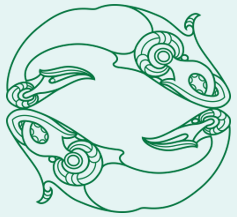The Arrival of Ngāti Kuia
Ngāti Kuia are the first people of Te Tauihu we are the descendants of Māui, Kupe, and Matua Hautere.
It was Matua Hautere who was brought to this place by the taniwha Kaikaiāwaro and it was the people of Matua Hautere, Ngāti Kuia, who settled the land – Te Hoiere.
The challenges Ngāti Kuia face today are different from those faced by their tūpuna, yet as Tangata Whenua the obligations to those tūpuna, the land, and those who follow, remains. Ngāti Kuia is bound by whakapapa and guided by the principles of kotahitanga, whanaungatanga, whāngai, and manaakitanga and must ensure that the land continues to speak. In doing this the land, as it has always done, will protect and enhance the mana of its first people – Ngāti Kuia.

Kaikaiāwaro
Te Hoiere
Motuweka (the site of present-day remain Havelock) is located at the confluence of the Kaituna and Awanui Rivers. These two rivers feed the body of water known as Te Hoiere (Pelorus Sound).
The traditions surrounding the creation of Te Hoiere and the history of tangata whenua (people of the land/first people) are intimately connected with the taniwha Kaikaiāwaro (known by the settler community as Pelorus Jack). Kaikaiāwaro created Te Hoiere by carving it out with his nose and it was Kaikaiāwaro who guided the ancestor Matua Hautere to this place. Over time the descendants of Matua Hautere, the Ngāti Kuia, occupied the bays and inlets of Te Hoiere utilizing its many resources. The Kaituna and Awanui rivers provided an abundance of eels. From the islands at the entrance of Te Hoiere, Ngāti Kuia harvested seabirds. Its waters supplied a plethora of fish species, and of course, from its shores were gathered many shellfish such as the mussel.
In the period leading up to formal colonization, Ngāti Kuia withstood the raids of northern tribes armed with muskets. Although this resulted in the loss of life, Ngāti Kuia remained in Te Hoiere and continued to utilize the resources of the area. From 1840 the Crown began extending its authority. Governor George Grey set about purchasing large areas of the South Island dealing firstly with those tribes deemed to have the greatest rights, that is, those who had arrived with the musket.
In 1856, Ngāti Kuia, as a fait accompli, signed a Deed of Sale with the Crown. The sale included the land on which Havelock now sits. In return Ngāti Kuia was promised schools and hospitals and enough land to cater for the present and future needs of the tribe. As is the story of colonization, the Crown fell short of its promises.
Government policy was one of amalgamation, Ngāti Kuia were gradually reduced to living on small reserves where they were expected to become farmers, even though many of those reserves where prone to flooding. Although Ngāti Kuia continued to utilise traditional food sources, the Crown undermined such practices by imposing a newly discovered western conservation ethic. Islands that once provided food and that Ngāti Kuia have consistently stated they did not sell, would over time become nature reserves and off-limits to tangata whenua. Western farming practices ensured that wet lands, another important food source, would be drained or become dump sites. Ngāti Kuia deed of settlement with the Crown in 2010. Many of these issues remain unresolved.
Historic
Ngāti Kuia gave their voice to the land which gave us a reason to speak. Through generations, Ngāti Kuia became one with Ngāti Wairangi, Ngāti Kopia, Ngāti Haua, Ngāi Tawake, Ngāti Whakamana, Ngāi Te Heiwi and Ngāti Tumatakokiri. Ngāti Kuia endured the coming of Ngā Iwi Hou and Pākehā.